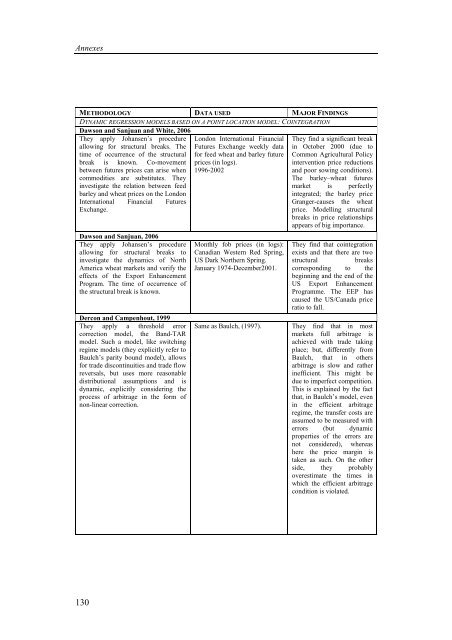TESTING INTERNATIONAL PRICE TRANSMISSION UNDER ...
TESTING INTERNATIONAL PRICE TRANSMISSION UNDER ...
TESTING INTERNATIONAL PRICE TRANSMISSION UNDER ...
Create successful ePaper yourself
Turn your PDF publications into a flip-book with our unique Google optimized e-Paper software.
Annexes<br />
METHODOLOGY DATA USED MAJOR FINDINGS<br />
DYNAMIC REGRESSION MODELS BASED ON A POINT LOCATION MODEL: COINTEGRATION<br />
Dawson and Sanjuan and White, 2006<br />
They apply Johansen’s procedure<br />
allowing for structural breaks. The<br />
time of occurrence of the structural<br />
break is known. Co-movement<br />
between futures prices can arise when<br />
commodities are substitutes. They<br />
investigate the relation between feed<br />
barley and wheat prices on the London<br />
International Financial Futures<br />
Exchange.<br />
Dawson and Sanjuan, 2006<br />
They apply Johansen’s procedure<br />
allowing for structural breaks to<br />
investigate the dynamics of North<br />
America wheat markets and verify the<br />
effects of the Export Enhancement<br />
Program. The time of occurrence of<br />
the structural break is known.<br />
Dercon and Campenhout, 1999<br />
They apply a threshold error<br />
correction model, the Band-TAR<br />
model. Such a model, like switching<br />
regime models (they explicitly refer to<br />
Baulch’s parity bound model), allows<br />
for trade discontinuities and trade flow<br />
reversals, but uses more reasonable<br />
distributional assumptions and is<br />
dynamic, explicitly considering the<br />
process of arbitrage in the form of<br />
non-linear correction.<br />
130<br />
London International Financial<br />
Futures Exchange weekly data<br />
for feed wheat and barley future<br />
prices (in logs).<br />
1996-2002<br />
Monthly fob prices (in logs):<br />
Canadian Western Red Spring,<br />
US Dark Northern Spring.<br />
January 1974-December2001.<br />
Same as Baulch, (1997).<br />
They find a significant break<br />
in October 2000 (due to<br />
Common Agricultural Policy<br />
intervention price reductions<br />
and poor sowing conditions).<br />
The barley–wheat futures<br />
market is perfectly<br />
integrated; the barley price<br />
Granger-causes the wheat<br />
price. Modelling structural<br />
breaks in price relationships<br />
appears of big importance.<br />
They find that cointegration<br />
exists and that there are two<br />
structural breaks<br />
corresponding to the<br />
beginning and the end of the<br />
US Export Enhancement<br />
Programme. The EEP has<br />
caused the US/Canada price<br />
ratio to fall.<br />
They find that in most<br />
markets full arbitrage is<br />
achieved with trade taking<br />
place; but, differently from<br />
Baulch, that in others<br />
arbitrage is slow and rather<br />
inefficient. This might be<br />
due to imperfect competition.<br />
This is explained by the fact<br />
that, in Baulch’s model, even<br />
in the efficient arbitrage<br />
regime, the transfer costs are<br />
assumed to be measured with<br />
errors (but dynamic<br />
properties of the errors are<br />
not considered), whereas<br />
here the price margin is<br />
taken as such. On the other<br />
side, they probably<br />
overestimate the times in<br />
which the efficient arbitrage<br />
condition is violated.
















